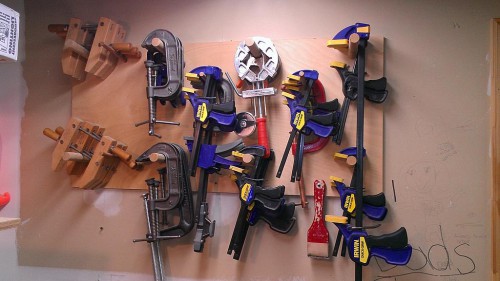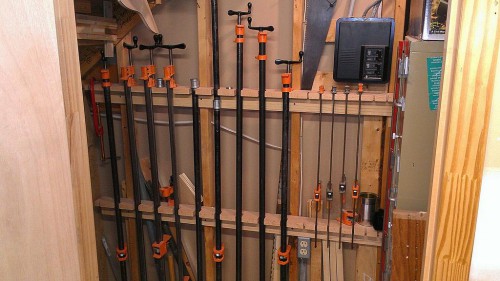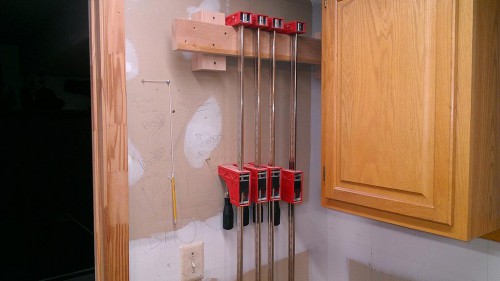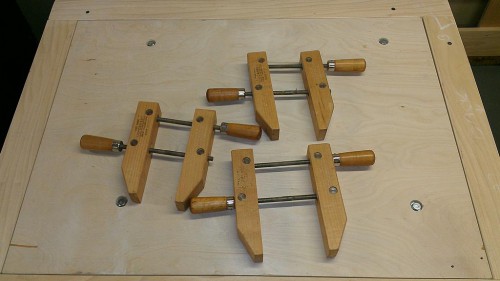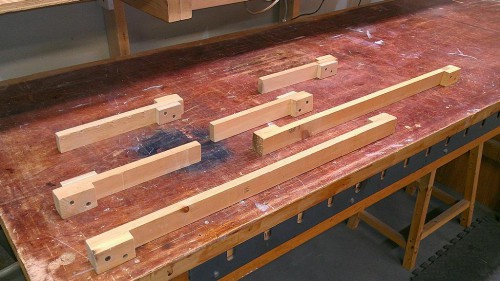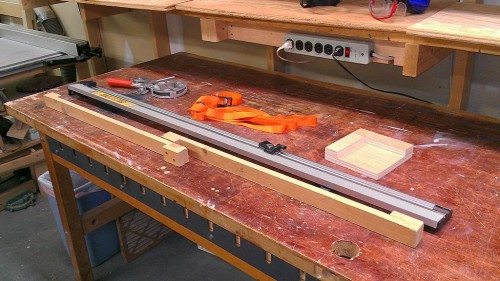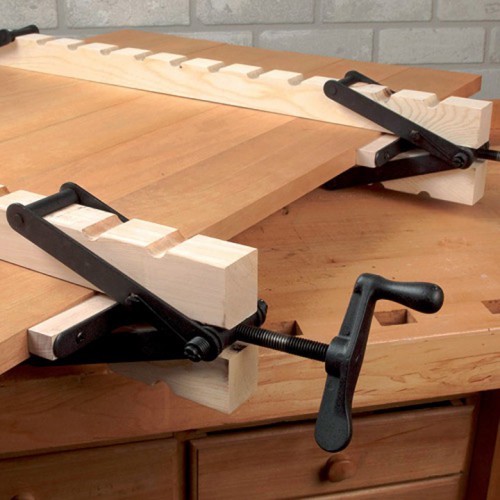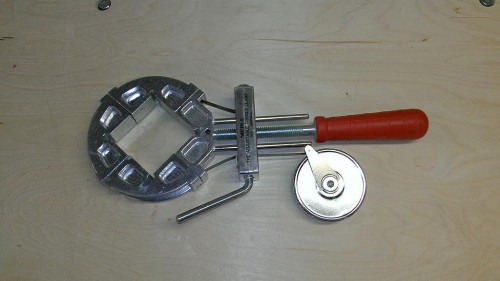Like most woodworkers, I have accumulated quite an assortment of woodworking clamps over the years. As someone once said, you can never have too many clamps. Of course, I love, er… I mean like some of my clamps more than others…
The clamps I use most often are trigger-action mini bar clamps. They’re lightweight, adjust quickly and best of all, can be used with just one hand. Just slide em in position, squeeze until tight, and move on. This allows you to hold the piece with one hand and clamp with the other. These clamps come in a range of sizes, from about 6 inches to a few feet although I mostly use the 6 inch variety.
Trigger-action clamps have soft plastic pads that provide decent grippage without marring the wood surface. They are best for applications that don’t require immense clamping power. If I was gluing up a panel, they wouldn’t be my first choice. Although I do use them for project joinery, I often find myself using them to secure a work piece to the workbench, to temporarily hold a board in position until it’s screwed in place, or as part of a jig. I like them – a lot.
The venerable 3/4″ pipe clamp gets a lot of use in my shop also. These clamps deliver considerable clamping pressure, are relatively cheap, and are available in almost any size — depending on the length of pipe. With pipe clamps, you typically use 3/4″ black (not galvanized) pipe with threads on one end for the clamping head to screw onto. The adjustable tail stock slides onto the other end. Then it’s off to the races.
I have about 12 pipe clamps in my shop in lengths ranging from 2 feet to 5 feet. What if I need something longer? Well, I can certainly buy a long piece of pipe but I find it more practical to join together two smaller pieces of pipe using a coupler. This way, I can just disassemble the larger pipe when done and don’t need to store a long unwieldy piece that will likely be used very infrequently.
Pipe clamps work well for gluing up panels and general purpose furniture assembly. As an example, in building a queen-sized Murphy bed, I used pipe clamps to glue together the panels on the underside of the bed which measured almost 7 feet across. This involved using the afore-mentioned pipe coupler to create extra long clamps.
I also have a few 4-ft I-beam bar clamps in my clamp arsenal. Compared to their pipe clamp brethren, I-beamers are more rigid and deliver awesome clamping pressure. They also cost quite a bit more. That’s probably why I only have a few. Meanwhile, the smaller bar clamps come in handy for lighter-duty clamping tasks and situations where there is limited maneuvering space. If I need a little more clamping oomph than what a trigger clamp can deliver but not quite so much as a pipe clamp, I reach for the bar clamps. One of the really nice things about bar clamps is that it’s hard to over tighten them. This minimizes the risk of joint failure or damaging the wood surface.
I picked up a set of Jet parallel clamps several years ago and have become quite fond of them. As advertised, the jaws on these clamps do stay parallel which makes for an easier, more predictable clamping experience compared to pipe or bar clamps. Furthermore, the jaws are made from a non-mar plastic so there’s no fussing around with wooden blocks to protect the furniture surfaces. The main downside to parallel clamps is that they are a tad expensive.
Early in my woodworking days, I picked up a half dozen wooden handscrew clamps. Although I don’t use them nearly as much as I once did – perhaps due to the emergence of more user-friendly trigger clamps – they do have their place. I often use handscrew clamps for gluing up thin stock to create thicker boards. As an example, I once made a set of floor lamps and used hand screws to glue together three 3/4″ thick boards to create 2-1/4″ thick pieces for the uprights. Three clamps on one side, three on the other, a twist here, a twist there, and Bob’s your uncle.
Another standby in my shop is the old-fashioned C clamp. The important thing with C clamps is to buy quality. The cheaper ones often have excessive play in the threads and as you tighten them, the swivel pad tends to wobble around, sometimes causing the glued-up pieces of wood to shift. This is especially problematic with larger clamps. I have a collection of 4″ Jorgensen C clamps and have been very happy with them. You can really clamp down with these babies and there is very little thread wobble.
If you need some extra long clamps for an oversized project and don’t have any sufficiently long pipe clamps (or pipe couplers), one solution is home-made clamp extenders. These are simply pieces of wood with wooden blocks attached to each end. One end forms a clamping point and the other end fits over the edge of the work piece. I made a bunch of clamp extenders for a platform bed project and have used them for several other projects since. If I’m running low on long pipe clamps or just don’t feel like taking the time to splice together shorter pipe clamps to make long clamps, these home-made clamp extenders are just the ticket. Can’t beat the price either.
Straight-edge clamps (also called bench clamps) are relatively new on the woodworking scene. These are essentially a combination clamp and edge guide made from lightweight aluminum. I’ve seen demos at woodworking shows where they use straight-edge clamps for every imaginable clamping application but I typically only use mine for cross-cutting and routing dados in plywood. I’ve read that they can function well as adjustable fences for drill presses, router tables, and the like but I can’t offer any first-hand experience. Maybe one of these days…
In what I consider the “experimental” clamp department, we have the 4-Way Equal Pressure Clamp, designed to apply equal pressure from all four directions (sides, top and bottom). The marketing pitch for this clamp is that it prevents bowing or buckling when gluing up wood panels because of the pressure applied to the top and bottom of the panel. My experience with the 4-way pressure clamp is that it gets the job done but requires a bit of mucking around to get it in position. Also, it is less effective at aligning joints on larger panels because less pressure gets applied in the center of the panel. For these reasons, my 4-way pressure clamps have been collecting dust in a utility closet next to the woodshop.
I occasionally use band clamps for picture frames and specialty projects. I’ve had good results with the Merle Band Clamp for gluing up picture frames. It uses a steel band which allows you to really bear down and tighten up those miter joints. The twist action tightening mechanism is also appreciated. If less pressure is needed or if the item is somewhat irregular in shape, I’ll pull out the Pony band clamp. It has a nylon band that you tighten up via a ratcheting mechanism (which can sometimes be a pain because it tends to twist).
My clamp wish list includes deeper capacity C-clamps and bar clamps (Wetzler makes some bar clamps with up to a 12″ jaw depth), Bessey corner clamps, and a heavy duty wood vise. Perhaps I’ll report on these clamps in a future article…
Happy clamping!


